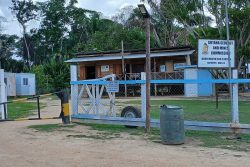Introduction
In my two previous Sunday columns, I had developed the argument to the effect that the steep increases in remittance flows to Guyana (as well as Jamaica) reflect both criminally-inspired transfers along with transfers made by hard-working Guyanese and Jamaican emigrants living in the diaspora. Of course, I am in no position to determine the respective shares of these two sources. However, I am confident that, given the growth rate of remittance inflows to Guyana, (which exceeded 50 per cent each year for the five years preceding the global crisis) this cannot be explained by income changes, employment opportunities and earnings, or prosperity levels in the countries in which these emigrants live. In none of these has the growth of income per head approached even one tenth of the rate at which remittances have grown.
 Such a conclusion logically leads into a discussion of the performance of the underground/illegal economy, and in particular that part of it, which can be said to represent the proceeds of organised crime. In earlier columns I had labelled this segment of the underground economy, the ‘phantom economy.’
Such a conclusion logically leads into a discussion of the performance of the underground/illegal economy, and in particular that part of it, which can be said to represent the proceeds of organised crime. In earlier columns I had labelled this segment of the underground economy, the ‘phantom economy.’
Studies
When I had last addressed this topic in earlier Sunday Stabroek columns there were only three completed studies seeking to measure the size of the underground economy of Guyana, with which I was acquainted. These were in order of the date of publication: first, my own effort (Foreign Currency Black Markets: Lessons from Guyana, published in the journal, Social and Economic Studies in 1989; second, a study by Professor Karl Bennett entitled Economic Decline and the Growth of the Informal Sector: the Guyana and Jamaica Experience, published in the Journal of International Development in 1995; and third, the study by Ebrima Faal, Currency Demand, the Underground Economy and Tax Evasion: the Case of Guyana published in 2003 as an IMF Working paper (WP/03/07).
Since then, three new studies have been published within the past year or so. One of these is written by Guillermo Vuletin, entitled, Measuring the Informal Economy in Latin America and the Caribbean, This has been published by the IMF as a Working paper (WP/08/102). The second has been co-authored by myself and two of my colleagues in the Faculty of Social Sciences, University of Guyana (Natoya Stephen Jourdain and Sukrishnalall Pasha) and presented to the 41st Annual Conference of Monetary Studies held in Guyana last year (November 2009). This study is entitled Revisiting the Underground economy in Guyana 2001-2008. The third study has been co-authored by my two colleagues mentioned above for presentation at the 42nd Annual Conference on Monetary Studies to be hosted by the Central Bank of Trinidad and Tobago (November, 2010). This study is entitled Estimating the Underground Economy in Guyana: An Alternative Approach.
It is my intention to present a summary of the results of these studies in next week’s column, in so far as they pertain to estimating the size of the underground economy in Guyana. The standard practice is to express the size of the underground economy as a percentage of the official GDP of the country for which it is being estimated.
Two key characteristics
Before I get to this, however, it would be useful to consider a couple of key characteristics involved in researching the underground economy. The first of these is that it is the practice for different authors to label what I have termed here as the underground economy differently. There is the widespread use of a number of such terms including parallel economy, unreported economy, informal economy, hidden economy, shadow economy, irregular economy, black market economy, and so on. These do not all carry the same meaning when it comes to deciding what to include in the measures and it is therefore important for readers to keep this in mind.
It is for that reason that I prefer to use the notion of a two by two matrix to represent what is being considered. On one side of this matrix, transactions are classified as to whether they are illegal or legal. And on the other side, transactions are classified in terms of whether they are settled in cash (including other financial instruments like cheques, money orders and bank drafts) or they are settled in-kind (for example, a share of the item involved in the transaction – drugs!)
The second characteristic to keep in mind is that the underground of economy is found in every country on earth. What is considered of crucial importance is the respective size (expressed as a ratio of the country’s GDP), as this varies widely. From numerous surveys it has come to be acknowledged by researchers that there are two key drivers which shape the illegal underground economy. One of these is tax evasion, and the other is to seek the monetary rewards which come from non-compliance with the regulatory authorities.
Persons seek to evade taxes on either their income or wealth or both. This may have been either lawfully acquired or acquired through criminal activity. Similarly, being non-compliant with the authorities does not necessarily mean that the activity/transaction is illegal. Thus for example, a person may legally mine for gold in Guyana but does not comply with the regulation to sell the gold to the Gold Board. Similarly a person may manufacture an item that is legally prohibited, such as cocaine. Tax evasion refers to evading the payment of taxes on both lawful and illegally earned income and acquired wealth.
To qualify as part of Guyana’s underground economy, all the economic transactions associated with these activities are required to take place in Guyana’s territory. However they certainly could involve the participation of economic agents who do not reside in Guyana.
When I refer to the phantom economy in this discussion I am referring to wholly illegal activities, typically undertaken by highly organised transnational criminal enterprises, which operate through locally-based networks. The typical activities pursued by these groups are drug trafficking, trafficking in persons, organised prostitution, arms smuggling and their associated money laundering.
In next week’s column I shall briefly address the methods used to measure the underground economy in the studies mentioned above and share the results provided in the studies.










